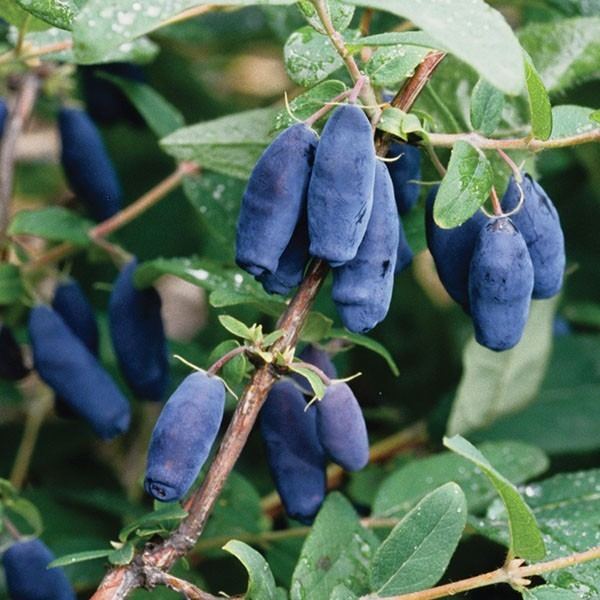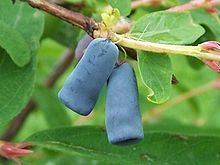Scientific name Lonicera caerulea Rank Species | Genus Lonicera Higher classification Honeysuckle | |
 | ||
Similar Chokeberry, Shadbush, Hardy kiwi, Gooseberry, Saskatoon | ||
Honeyberry plants lonicera caerulea
Lonicera caerulea, the honeyberry, blue-berried honeysuckle, or sweetberry honeysuckle, is a honeysuckle native throughout the cool temperate Northern Hemisphere. It is a deciduous shrub growing to 1.5–2 m tall. The leaves are opposite, oval, 3–8 cm long and 1–3 cm broad, glaucous green, with a slightly waxy texture. The flowers are yellowish-white, 12–16 mm long, with five equal lobes; they are produced in pairs on the shoots. The fruit is an edible, blue berry about 1 cm in diameter.
Contents
- Honeyberry plants lonicera caerulea
- Lonicera caerulea 2012
- Classification
- Varieties
- Common names
- Distribution and habitat
- Cultivation
- Disease
- Harvest and uses
- Phytochemicals
- Traditional medicine
- References

Lonicera caerulea 2012
Classification
The classification within the species is not settled. One classification uses nine varieties:

Varieties

According to research at the University of Saskatchewan, each variety can be distinguished by the size of berries, taste, and bush dimensions.
Common names
Lonicera caerulea is known by several common names

Distribution and habitat
The species is circumpolar, primarily found in or near wetlands of boreal forests in heavy peat soils. However, it also can be found in high-calcium soils, in mountains, and along the coasts of northeastern Asia and northwestern North America. The plant is winter-hardy and can tolerate temperatures below minus 47 degrees Celsius.
Cultivation
Haskap variety edulis has been used frequently in breeding efforts, but other varieties have been bred with it to increase productivity and flavor. In several haskap breeding programs, the variety emphyllocalyx has been the dominant one used.
Plants of many haskap cultivars grow to be 1.5 to 2 meters tall and wide, can survive a large range of soil acidity, from 3.9-7.7 (optimum 5.5-6.5), requiring high organic matter, well drained soils, and plentiful sunlight for optimum productivity. Lonicera caerulea plants are more tolerant of wet conditions than most fruit species.
Each berry has approximately 20 seeds that resemble tomato seeds based on their size and shape, but the seeds are not noticeable during chewing.
Disease
Powdery mildew is one disease documented to affect Lonicera caerulea, usually after fruit maturity in mid– to late summer. When the plant is affected, it is common for the leaves to turn white with brown patches eventually developing.
Harvest and uses
Honeysuckle is harvested in late spring or early summer two weeks before strawberries for Russian type varieties, with Japanese types ripening at a similar time to strawberries. The berries are ready to harvest when the inner layer is dark purple or blue. The outer layer is dark blue and looks ripened, but the inner layer may be green with a sour flavor. Two compatible varieties are needed for cross pollination and fruit set. In North America, most Russian varieties are adapted to hardiness zones 1 to 4. The plants may take three or four years to produce an abundant harvest. Average production on a good bush is about 3 kilograms (6.6 lb) and can maintain productivity for 30 years.
Honeysuckle can be used in various processed products, such as pastries, jams, juice, ice cream, yogurt, sauces, candies and a wine similar in color and flavor to red grape or cherry wine.
Phytochemicals
As a blue pigmented fruit, Lonicera caerulea contains polyphenol compounds, including cyanidin 3-glucoside, cyanidin 3-rutinoside, and peonidin 3-glucoside. Other phytochemicals present are proanthocyanidins and organic acids, including a high content of citric acid.
Traditional medicine
Over centuries, Lonicera caerulea has been used in traditional medicine in East Asian countries for a variety of therapeutic applications.
